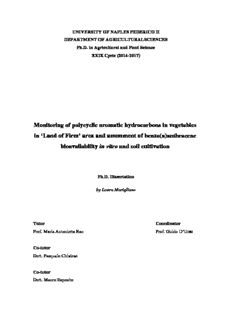Table Of ContentUNIVERSITY OF NAPLES FEDERICO II
DEPARTMENT OF AGRICULTURAL SCIENCES
Ph.D. in Agricultural and Food Science
XXIX Cycle (2014-2017)
Monitoring of polycyclic aromatic hydrocarbons in vegetables
in ‘Land of Fires’ area and assessment of benzo(a)anthracene
bioavailability in vitro and soil cultivation
Ph.D. Dissertation
by Laura Marigliano
Tutor Coordinator
Prof. Maria Antonietta Rao Prof. Guido D’Urso
Co-tutor
Dott. Pasquale Chiaiese
Co-tutor
Dott. Mauro Esposito
Acknowledgments
Here I am, at the end of these three years of study. They have been years full of
engagement and experience that have helped me to grow professionally and humanly.
It is difficult to remember in few lines all the people who, for a number of reasons, have
accompanied me along this path, helping to make it "better".
I would dedicate special thanks to Prof. Maria Rao for the theoretical and methodological
contribution that she gave me. She supervised me in this research with dedication and I
appreciated her sweetness of mind, fairness, love for research and professionalism. She
will be always for me a model to follow in both life and work.
Thanks to my co-tutors Dr. Pasquale Chiaiese and Dr. Mauro Esposito who supervised
me with patience and professionalism.
I would like also to thank all the colleagues and friends, especially Antonella De Roma
and Giuseppe Di Rauso Simeone, whose friendship has been for me a treasure uncovered
by chance in this difficult adventure and without that doctoral dissertation would not have
been equally precious.
Finally, I thank immensely my family for having always been alongside me, inciting me
to give my best efforts.
INDEX
1 INTRODUCTION ................................................................................................... 3
1.1 Persistent organic pollutants ................................................................................... 3
1.2 Ubiquitous environmental pollutants: polycyclic aromatic hydrocarbons .............. 5
1.3 Toxicity and bioavailability of PAHS ..................................................................... 8
1.4 European policies on PAH content in food ........................................................... 12
1.5 Aim ........................................................................................................................ 13
1.6 References ............................................................................................................. 16
2 MONITORING OF PAH CONTAMINATION IN VEGETABLES
AND FRUITS: CASE STUDY “LAND OF FIRES” ......................................... 23
2.1 Introduction ........................................................................................................... 23
2.2 Aim ........................................................................................................................ 29
2.3 Materials and methods .......................................................................................... 30
2.3.1 Sampling sites ................................................................................................... 30
2.3.2 Sampling methods ............................................................................................ 32
2.3.3 Sampling in orchards ........................................................................................ 32
2.3.4 Sampling in vineyards ...................................................................................... 33
2.3.5 Sampling in vegetable crops ............................................................................. 33
2.3.6 Sampling in greenhouses .................................................................................. 34
2.3.7 Sampling of arable crops .................................................................................. 34
2.3.8 Vegetables and fruits ........................................................................................ 34
2.3.9 Chemicals ......................................................................................................... 35
2.3.10 Sample preparation, extraction and clean-up ................................................... 37
2.3.11 High-performance liquid chromatography (HPLC) analysis ........................... 37
2.3.12 Validation method ............................................................................................ 38
2.4 Results and discussion ........................................................................................... 39
2.4.1 PAH contamination in vegetables and fruits in Naples province ..................... 39
2.4.2 PAH contamination in vegetables and fruits in Caserta province .................... 54
2.4.3 Dietary exposure assessment ............................................................................ 66
2.5 Conclusions ........................................................................................................... 72
2.6 References ............................................................................................................. 74
3 BIOAVAILABILITY OF BENZO(A)ANTHRACENE IN
VEGETABLES ...................................................................................................... 79
3.1 Introduction ........................................................................................................... 79
3.2 Materials and methods.......................................................................................... 81
3.2.1 Chemicals ......................................................................................................... 81
3.2.2 Soil.................................................................................................................... 81
3.2.3 Germination test ............................................................................................... 82
3.2.4 In vivo cultivation of turnip and tomato plants in BaA contaminated soil .... 83
3.2.5 In vitro cultivation of turnip and tomato plants in BaA contaminated culture
medium ............................................................................................................. 85
3.2.6 BaA measurement ............................................................................................ 88
3.2.7 Statistical analysis............................................................................................ 89
3.3 Results and discussion ........................................................................................... 90
3.3.1 Germination test in presence of BaA contaminated soil .................................. 90
3.3.2 Cultivation of turnip and tomato plants in BaA contaminated soil .................. 92
3.3.3 Contamination of turnip and tomato plants cultivated in BaA contaminated MS
medium ............................................................................................................. 99
3.4 Comparing remarks ............................................................................................. 105
3.5 Conclusions ......................................................................................................... 106
3.6 References ........................................................................................................... 107
Chapter 1
1 INTRODUCTION
1.1 Persistent organic pollutants
Contamination of environment with hazardous and toxic chemicals is one of the
major problems facing the industrialized world today. Among the contaminants present
in the environment, Persistent Organic Pollutants (POPs) are a group of toxic,
bioaccumulative substances including a wide variety of compounds belonging to different
chemical classes, such as polychlorinated biphenyls (PCBs), organochlorine pesticides
(OCPs), polycyclic aromatic hydrocarbons (PAHs). They are easily available to
environmental transport over long distances once introduced in the environment by
human activities (Figure 1.1).
Figure 1.1: Transport of pollutants (from www.anka.kit.edu/28.php).
The atmospheric transport has been identified as the main cause of long-range
transport and global dispersal of POPs (Teran et al., 2012). The latter can move (indirect
transport) from source to pristine and remote areas by a phenomenon called global
distillation (Wania and Mackay, 1995). Pollutants released into the environment vaporise
when temperature raises and are carried around by winds until temperature cools and
condensation occurs. Drop deposition can occur when chemicals are blown to cooler
climates or when seasons change. A further effect is the atmospheric transport from low
to high latitude and altitude (Wania and Mackay, 1995).
Since global distillation is a relatively slow process depending on successive
3
evaporation/condensation cycles, it is only effective for semi-volatile chemicals that
break down very slowly in the environment, such as PAHs, dioxin and polychlorinated
biphenyls (Wania and Mackay, 1995).
Atmospheric deposition of pollutants can occur simply by gravity (dry deposition),
through the dissolution of organic vapours into rain and cloud droplets (washout and wet
deposition) (Bidlemann, 1988). Vegetables, in particular, plants having a relatively large
surface area covered with waxes that facilitates the accumulation of hydrophobic
chemicals, capture particulates through leaves then falling and releasing them to the soil
(Figure 1.2).
Figure 1.2: Indirect deposition of POPs by air transport.
POPs released into the environment tend to be diluted in matrices such as water
and air, while they tend to accumulate in the soil for various periods and they are subject
to partitioning, degradation, and transport processes depending on their physical-
chemical properties (Cetin and Odabasi, 2007).
The extent to which POPs react in the atmosphere can dictate their long-term
environment fate. If the atmospheric degradation reactions are slower than the deposition
4
Description:PAHs generally lack characteristics of electrophylicity that enable covalent be fixed by DNA repairing enzymes so they act as starters in chemical

